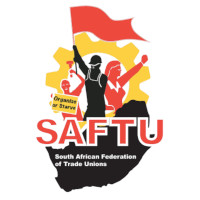The South African Federation of Trade Unions (SAFTU) is disappointed that the South African Reserve Bank (SARB) governor, Lesetja Kganyago, is still committed to the monetary framework that will hike interest rate at the expense of working-class households and small businesses.
In a lecture delivered at Wits University School of Governance, Lesetja Kganyago said that South Africa has “not reached the ‘end’ of our policy rate space”. In other words, the South African Reserve Bank (SARB) is still set to increase interest rates in the period lying ahead, starting with the meeting of the Monetary Policy Committee (MPC) arranged to sit on 24 November 2022.
SAFTU has previously argued that Kganyago’s instruments to fight inflation are blunt and are premised on the neoliberal misreading of the economy. In this lecture, where he tried to argue against expanding the mandate of the SARB to include jobs, he proved his commitment to the crudest dictates of neoliberalism.
In his conclusion, he rubbished those like us who are calling for expansionary policy to stimulate the economy and create jobs, whilst arguing for inflation targeting trajectory of policy rates.
Every problem needs a hammer?
Like he insists that the solution for job creation lies entirely outside of the monetary policy (which we do not agree with), we call on him to also look for other areas that could slow inflation than from his policy rate toolbox. His insistence to solve the rising
levels of inflation with interest rates have proven to be contradictory and painful for the working class.
In the first instance, the interest rate hikes are inflationary, as businesses absorb the credit and debt servicing costs through pricing of their products and services. This is contradicts the SARB’s intentions, as it accelerates inflation in the short term than slow it. Secondly, in order for the interest rate hikes to have deflationary impact as desired by the governor, they have to be raised to the levels that causes retrenchments and collapse small business – causing more unemployment. This is the only way, according to Kganyago, to minimise aggregate demand. It is the most painful and regressive way of dealing with inflation for the working class.
Here, Governor Kganyago, priding himself in regressive economics and belittling everybody who argues for monetary policy that is cognisant of human and developmental needs of the nation, brand them as being ideological and not understanding the dictates of economics. Meanwhile, he is obfuscating the fact that he is the one at the service of finance capital and those who trade in stocks of money and financial assets.
Our contention is that the current inflation confronting our country in particular, is not demand driven. It is because production is limping. The under-utilisation capacity of the manufacturing capacity is higher than it was during the financial crisis of 2007-2009: the under-utilisation was 14% in 2007 and today it is estimated at above 20%. This is despite the fact that population has grown and continues to grow. Raising this manufacturing capacity to accelerate higher will have deflationary pressure on the general prices of goods and services, than religiously using pain inflicting interest rates.
job creation and wages
In the past, we pointed out that profit motif and the neoliberal monetary strategies are testaments that unemployment is woven into the DNA of capitalism. In the speech, Governor Kganyago confirmed this analysis. He remarked that:
…there may be a rise in cyclical unemployment to get inflation back down and to achieve a lower sustainable unemployment rate.
In other words, unemployment is in the best interest of bringing inflation down according to Kganyago. Therefore, when policy rate induces unemployment, this is well and necessary for them. Though he is not explicitly revealing in the speech, inducing unemployment is their deliberate action to fight inflation.
His complains about the elevated level of NAIRU — non-accelerating inflation rate of unemployment — in South Africa are meant to theoretically justify that even at lowest levels considering the working age population that is unemployed, employment levels are currently accelerating inflation. Stretched to its logical conclusions, this argument says we must have more unemployment to lower inflation.
Additionally, the policy rates are deliberately hiked to increase the credit service costs for businesses so that they will not be able to afford adequate increases workers’ wages.
Clearly, policy rates are used to induce retrenchments and low wages as conduits for preventing higher inflation.
Organise to resist
Given a number of factors, general price acceleration (inflation) will not be stopped by hiking of policy rates as such. To stop inflation using policy rates come at a high social and economic cost. In addition to increasing the cost of living for the working-class
majority, it is leading to defaults, bankruptcy, low wages, retrenchments and contrary to Kganyago’s intention, even inflation in the intermediate period.
It means the working people are bracing for festive season characterised by unaffordable basic goods, and financial distress.
The working class movement must organise to wage a relentless fightback against the onslaught by capitalists and their lieutenants in the state. On 24 August, we set in motion a struggle to fight and resist any attempt to resolve the crisis of capitalism on the back of working people. This struggle must continue, be protracted and relentless.






